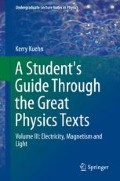Abstract
Until the time of Faraday, the action of magnets and electric charges were described almost exclusively in terms of their measured forces upon other nearby magnets and electric charges. Indeed, this was the disposition of many of the founders of the sciences of electricity and magnetism—men such as Coulomb, Biot, Poisson and Ampère. Like many of the French scientists, Michael Faraday was himself a very meticulous and well-respected experimentalist. But like Oersted, he made a decided break with the French empirical tradition by explaining electric and magnetic actions in terms of invisible—but nonetheless real—electric and magnetic fields. In his 1852 article entitled “On the Physical Character of the Lines of Magnetic Force,” published in The London, Edinburgh and Dublin Philosophical Magazine and Journal of Science, Faraday attempts to justify and defend his bold speculations. As you explore the text of this article, you might consider the following questions. Do you think that magnetic fields actually exist? If so, in what sense? Do they exist in the same sense that your hand exists? That light and gravity exist? That justice exists? That God exists? Or is the magnetic field perhaps just a useful (albeit disposable) conceptual hypotheses which we have inherited from the creative mind of Faraday?
I am now about to leave the strict line of reasoning for a time, and enter upon a few speculations respecting the physical character of the lines of force, and the manner in which they may be supposed to be continued through space.
—Michael Faraday
Access this chapter
Tax calculation will be finalised at checkout
Purchases are for personal use only
Notes
- 1.
See, for example, the section entitled “Biot and the Principles of Laplacian Physics,” starting on p. 118 of Hofmann, J. R., André-Marie Ampère: Enlightenment and Electrodynamics, Cambridge Science Biographies, Cambridge University Press, 1996. Also see James Clerk Maxwell’s discussion of action-at-a-distance and mediated action in Chap. 30 of the present volume.
- 2.
These quotes are from Ampère’s “On the mathematical theory of electrodynamic phenomena, experimentally deduced.” See pp. 155–200 of Tricker, R. A. R., Early Electrodynamics, Pergamon, New York, 1965.
- 3.
See Oersted’s Experiments on the Effect of a Current of Electricity on the Magnetic Needle in Chap. 7 of the present volume.
- 4.
Philosophical Transactions, 1846, p. 1.
- 5.
In this paragraph, Faraday is refers to his recent discovery that the plane of polarization of light is rotated when propagating through a magnetic field; see Tyndall’s explanation of the Faraday rotation of light in Chap. 24 of the present volume.—[K.K.]
- 6.
Experimental Researches, 8vo edition, vol. ii. pp. 191, 195.
- 7.
Philosophical Transactions, 1838, p. 16.
- 8.
Ibid. 1852.
- 9.
Philosophical Transactions, 1852.
- 10.
The manner in which a large powerful magnet deranges, overpowers, and even inverts the magnetism of a similar magnet, when it is brought near it in different directions without touching it, presents a number of such cases.
- 11.
Ann. de Chim.1822, vol. xxi. p. 47.
- 12.
Phil. Trans. 1823, p. 153.
- 13.
The lines of magnetic force have been already defined (3071.). They have also been traced, as I think, and shown to be closed curves passing in one part of the course through the magnet to which they belong, and in the other part, through space (3117.). If, in the case of a straight bar-magnet, any one of these lines, \(E\), be considered as revolving round the axis of the magnet, it will describe a surface; and as the line itself is a closed curve, the surface will form a tube round the axis and inclose a solid form. Another line of force, \(F\), will produce a similar result. The sphondyloid body may be either that contained by the surface of revolution \(E\), or that contained between the two surfaces of \(E\) and \(F\), and which, for the sake of brevity, I have (by the advice of a kind friend) called simply sphondyloid. The parts of the solid described, which are within and without the magnet, are in power equivalent to each other. When it is needful to speak of them separately, they are easily distinguished as the inner and outer sphondyloids; the surface of the magnet being then part of the bounding surface.
- 14.
Experimental Researches, 8vo edition, vol. ii. p. 127.
- 15.
CENCO Overbeck Electric Field Mapping Apparatus (Model No. CP79587-00), Sargent Welch, Buffalo Grove, IL.
Author information
Authors and Affiliations
Corresponding author
Rights and permissions
Copyright information
© 2016 Springer International Publishing Switzerland
About this chapter
Cite this chapter
Kuehn, K. (2016). The Magnetic Field. In: A Student's Guide Through the Great Physics Texts. Undergraduate Lecture Notes in Physics. Springer, Cham. https://doi.org/10.1007/978-3-319-21816-8_28
Download citation
DOI: https://doi.org/10.1007/978-3-319-21816-8_28
Published:
Publisher Name: Springer, Cham
Print ISBN: 978-3-319-21815-1
Online ISBN: 978-3-319-21816-8
eBook Packages: Physics and AstronomyPhysics and Astronomy (R0)

